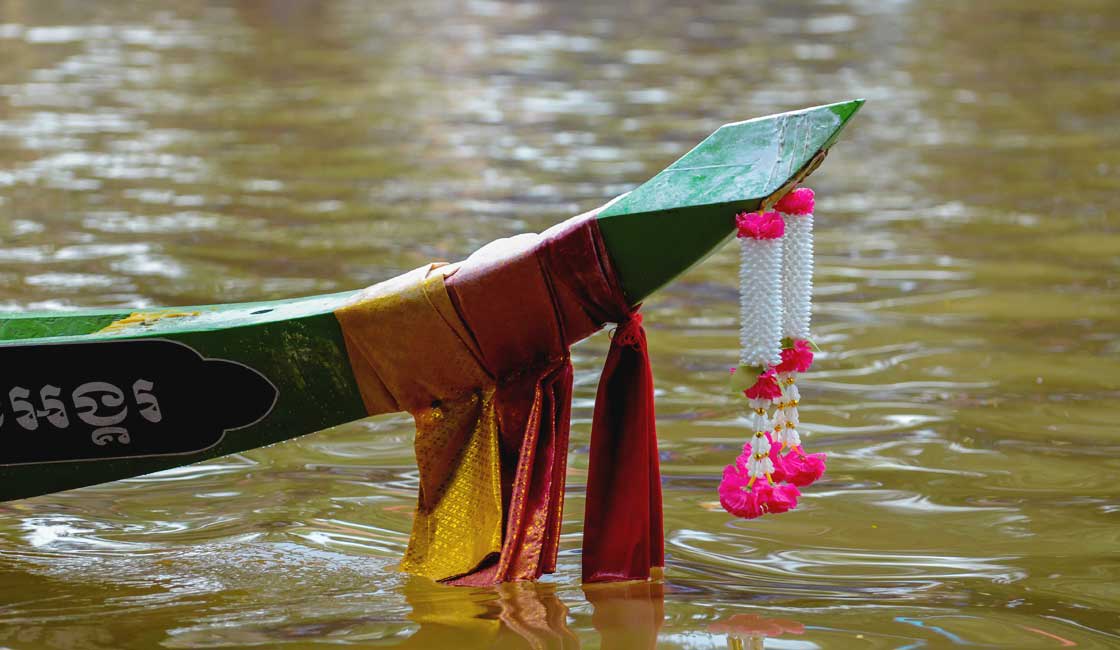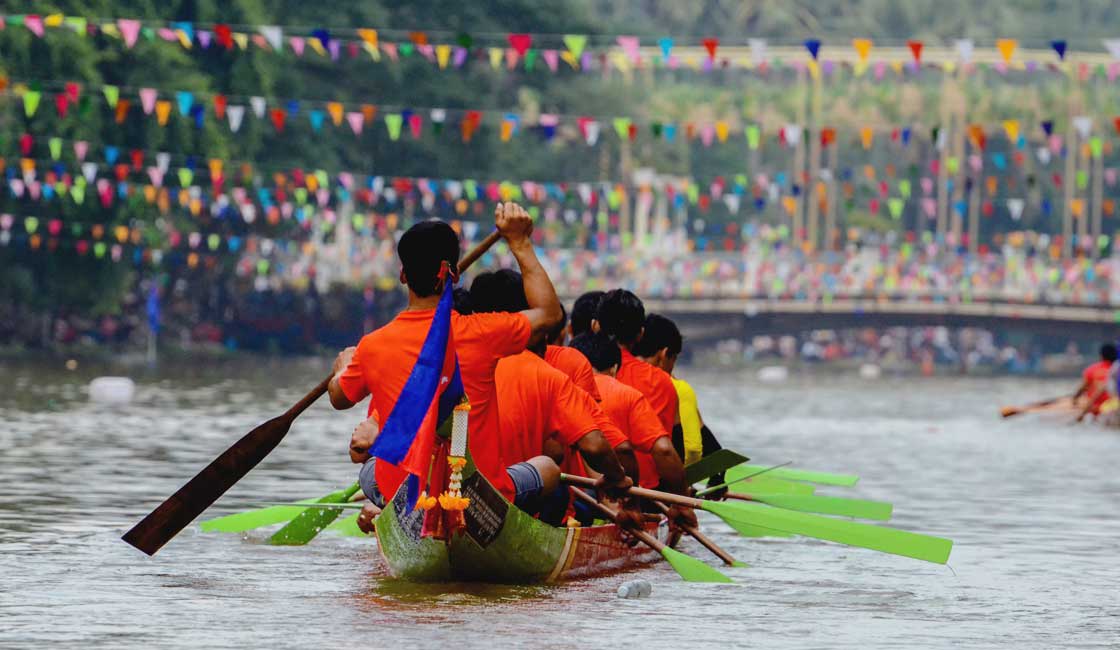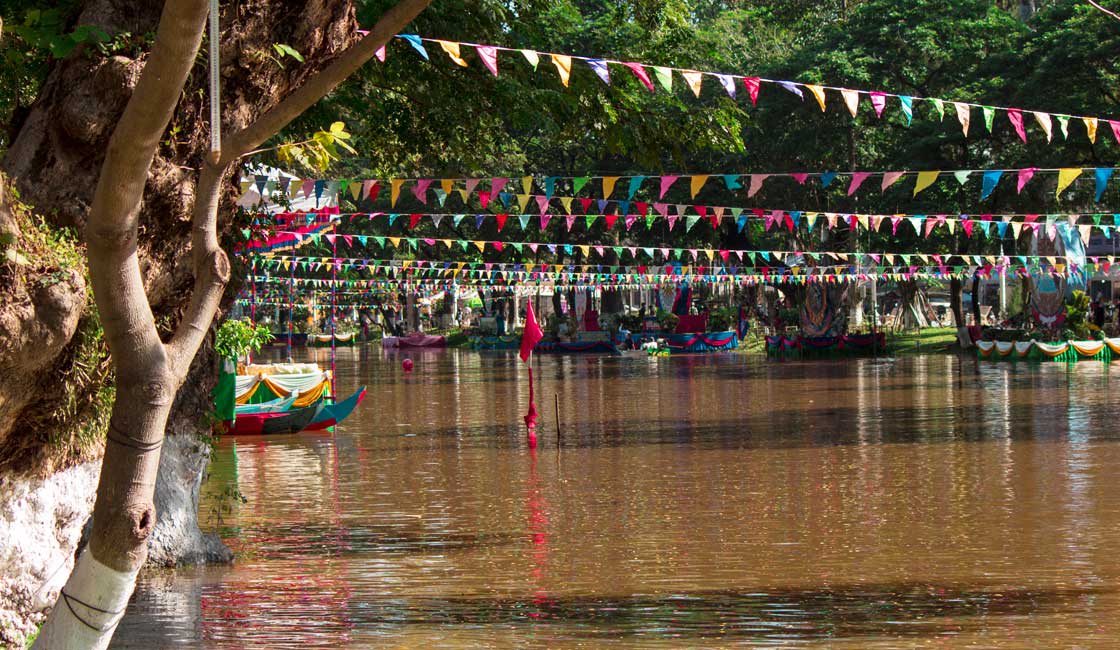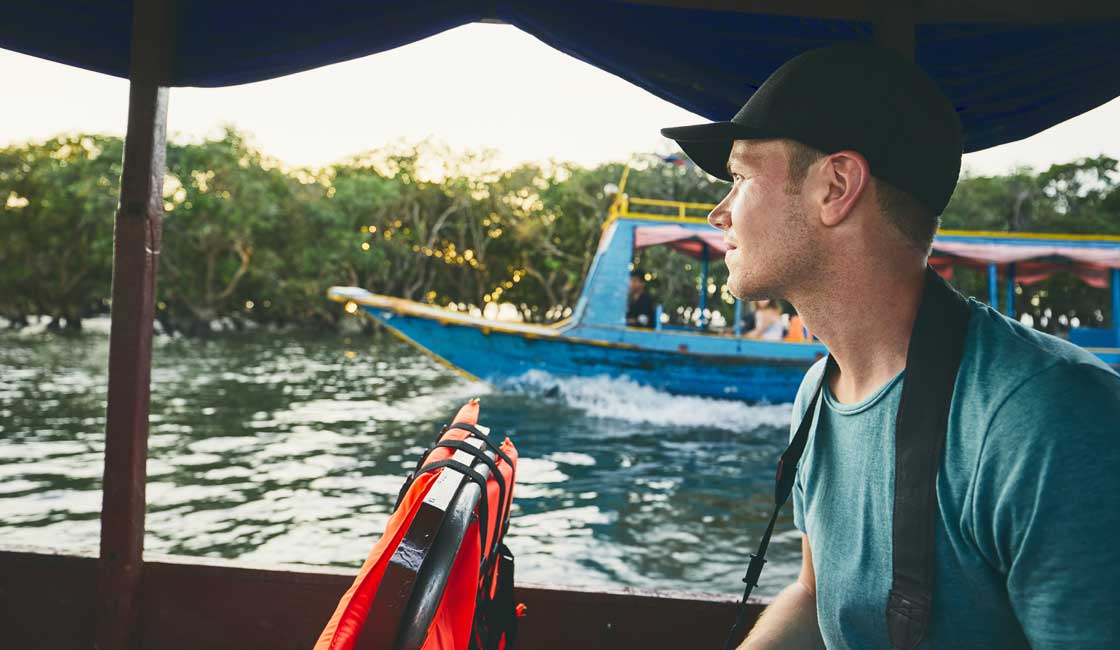
Illuminated boats speed across the Tonle Sap River like racing water dragons, their oarsmen bent over in fierce concentration. Fireworks light up the night sky under the glowing full moon, in a riotous kaleidoscope of vibrant colors.
Millions of people like the streets of Phnom Penh and Siem Reap for Cambodia’s biggest event of the year, and one of the most impressive spectacles you could ever hope to see: Bon Om Touk.
The Water Festival of Cambodia (known locally as Bon Om Touk) is the annual celebration of the life-giving waters of the Tonle Sap River, which is so crucial to the country’s prosperity. The end of the rainy season brings an abundance of fish and mineral-rich soil to the area surrounding the river, which for hundreds of years has been the lifeblood of the people of Cambodia. What better way to celebrate than with a massive festival!
Bon Om Touk is a huge festival and national holiday lasting three days, with celebrations happening all over the country. The dates of the festival vary with the moon cycle, but it is always held at the end of October or beginning of November.
The main celebrations are in the capital of Phnom Penh, and the former Angkorian capital of Siem Reap. All across the country schools are closed, workers have a holiday and people flock to celebrate the festival, with over a million people flooding Phnom Penh alone to watch the famous traditional boat races.
The festival marks one of the world’s most unique natural phenomenons, the reversal of the flow of the Tonle Sap River at the end of the monsoon season.
For six months of the year, the Tonle Sap River flows down from the Tonle Sap Lake to join the Mekong River at Phnom Penh. As the rainy season begins in May, the Mekong river swells rapidly and becomes a fast-flowing torrent. The sheer volume and force of water overwhelms the Tonle Sap tributary and forces the smaller river to flow backward, upstream into Tonle Sap Great Lake, swelling the lake to a massive 15,000km2 (roughly twenty times the size of New York City!).
This transforms the small body of water from a one-meter deep glorified swamp to a ten-meter deep great lake filled with fish and nutrient-rich sediment. This is a totally unique occurrence and the Tonle Sap River is the only river in the world to change its flow like this!

Boat racing in Siem Reap
Bon Om Touk is steeped in centuries of history, and the celebrations can be dated back to the Khmer empire. Evidence of the festival can be found on temple etchings at Bavon and Banteay Chhmar, and the festival’s inception can be dated back to the 12th-century rule of King Preah Bat Jayavarman VII.
During this time of Angkorian rule from the capital of Siem Reap in southern Cambodia, the Khmer Empire possessed a mighty naval army. This army achieved many victories against the Cham people of modern-day Vietnam and the Siam people of modern-day Thailand. It is said that the king organized a water festival in Cambodia for the dual purpose of selecting a champion of the navy from the boat races, and preparing his elite naval forces for battle.
Later, in the 16th century when the capital was moved from Siem Reap to Phnom Penh, the boat races were relocated to the junction of the Tonle Sap and Mekong rivers, where they are still held to this day.
Over the course of time, the purpose of the festival became less military and more celebratory, as the people gave thanks to their gods for the bounty that the water brings for fishermen and farmers. Through the years, the festival has proved a time of relief, solace, and happiness through troubles and turbulence in Cambodia. The brutal killing fields and totalitarian regime of the Khmer Rouge are still fresh in the minds of a generation of Cambodians, and oftentimes of adversity lend festivals and moments of relief like this extra importance.

Siem Reap dressed up for the festival
There are two main places to be during Bon Om Touk, and they are Phnom Penh and Siem Reap. There are pros and cons to both – so perhaps this will help you decide.
You can expect the festival in Phnom Penh to be much busier. The boat races are truly an incredible spectacle here, and the festival atmosphere is electric. Stalls line the banks of the river selling everything from street food to mobile phones and there are many musical concerts with bands playing and people dancing.
You can join the large crowds for the boat races at Sisowath Quay, or you can walk to the more sedate riverfront across the Japanese bridge at Chroy Changva and watch from the peninsula there. It is important to be vigilant for petty thievery in large crowds, as it is quite common in the capital. If the idea of large crowds doesn’t appeal, you could reserve a table at one of the many rooftop bars and restaurants along the riverfront and watch the boat races from there.
You would also have the chance to check out the french colonial architecture characteristic of the capital, and visit tourist attractions such as the Silver Pagoda, Wat Phnom, the National Museum, and the Royal Palace.
While nowadays the infrastructure is better, there have been safety issues in the past with the festival in the capital. In 2010, 345 people were tragically killed in a stampede on an overcrowded bridge during the final night of the festival. This led to proper security and crowd control measures being introduced and the festival is now much safer.
If you are looking for a slightly less chaotic and busy experience of the festival, Siem Reap may be for you. Although the town is still very busy with festival celebrations, the boat races are much smaller and the infrastructure is geared more towards tourists. This is the city where the festival originated in Angkorean times and maybe a better choice if you want to tie in your visit to the festival with a visit to the Angkor Wat temples.
Many of our river cruises visit Siem Reap, so you may be able to sync up a cruise with a visit to the festival. Check out our Mekong cruises for details on visiting Siem Reap.

On Tonle Sap Lake
So much of the life and prosperity of the Cambodian people is utterly dependent on the Tonle Sap River. It’s easy to see why the reversing of the river’s flow is seen as such an important event in the Cambodian calendar. The mineral-rich waters fertilize the land for farming and bring vast fish stocks into the area.
It really does seem like the river is looking after its people, and the Cambodian Water Festival is a great big thank you to the river that has given these people so much. It’s easy to see why many people consider Bon Om Touk is as much of a must-see attraction as the Angkor Temples.
While Rainforest Cruises aim to provide accurate and up-to-date information, we make no representations as to the accuracy or completeness of any information herein or found by following any link on this site. Rainforest Cruises cannot and will not accept responsibility for any omissions or inaccuracies, or for any consequences arising therefrom, including any losses, injuries, or damages resulting from the display or use of this information.




